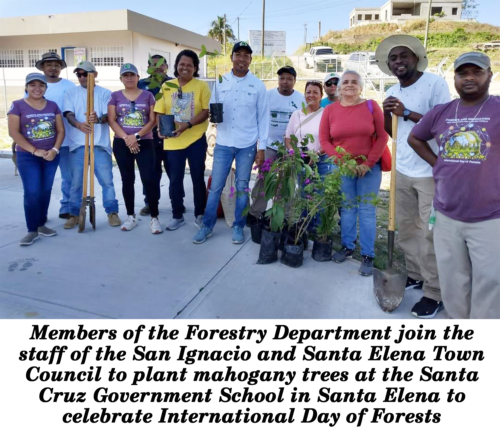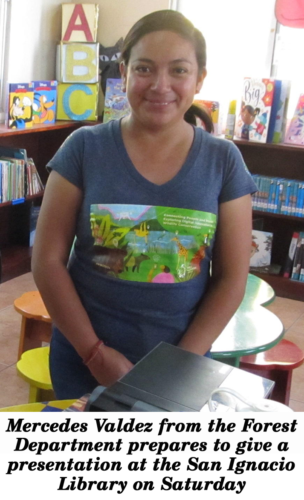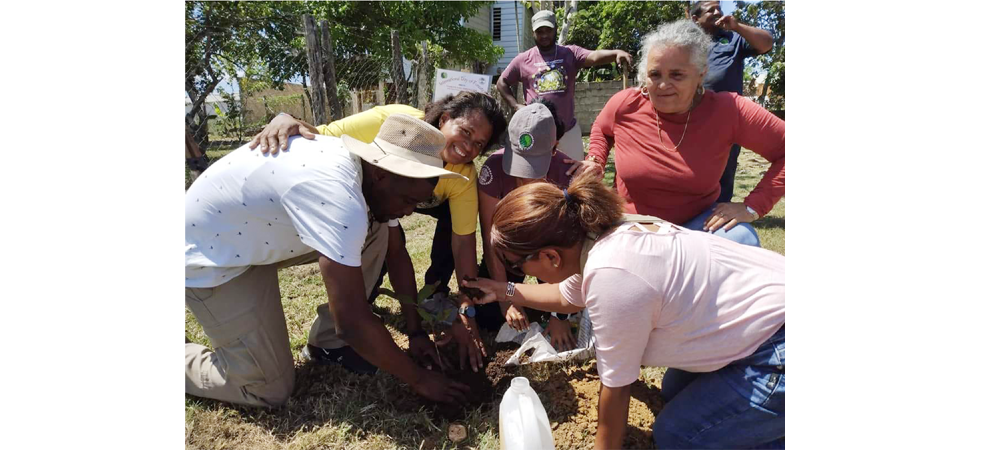Photo: Deputy Mayor of the San Ignacio and Santa Elena Town Council, Bernadette Fernandez, participates in the planting of mahogany trees within the Twin Towns
by Orlando Pulido
SANTA ELENA TOWN, Cayo District, Sun. Mar. 24, 2024
On March 21, Belize celebrated the International Day of Forests, a global observance that reminds us of the vital importance of these verdant ecosystems. The theme for this year’s International Day of Forests is, “Forests and Innovation: New Solutions for a Better World.”
To observe the day, the Forest Department did tree planting in both the San Ignacio and Benque Viejo areas. On Saturday, the Forest Department gave a presentation to children at the San Ignacio Library on the uses of the forest.

“One of those messages would be to not take wildlife or trees or our forests for granted. For example, we do get a lot of life-sustaining benefits from them; wildlife and forests are a source of protein, and we get free services such as clean air, and clean water. For instance, the village of San Antonio and some parts here in the Cayo District get their water source directly from the Mountain Pine Ridge,” said Mercedes Valdez, an employee from the Forestry Department.
Belize currently has 60% natural forest cover. For Wilber Sabido, Belize Chief Forest Officer, “It cannot continue to be business as usual on how we manage our forests. There are improvements that can be made in terms of techniques of restoration, using communities, indigenous groups.”
Sabido emphasized that we should not only take time out on March 21 to recognize our natural ecosystems, but to do so throughout the year, engaging our youths in the endeavor.

Since 2007, Friends for Conservation and Development (FCD) has been the guardian of Belize’s largest terrestrial protected area (285,937 acres), the Chiquibul National Park. The composition of the Chiquibul Forest is relatively well documented. The BERDS database contains 1,800 plant records from the Chiquibul Forest comprising 662 species as of August 2012. Through these various efforts 1,352 vascular plants, 318 species of trees, 246 species of shrubs, 452 species of herbs, 109 orchid species, 182 species of vines, 20 palms, 4 cacti, 3 cycads, 107 species of ferns, 14 woody parasites and 10 lycopods have now been recorded from the Chiquibul.
The 2004 version of the Belize Ecosystems Map (Meerman & Sabido, 2001) recognizes 17 ecosystems for the Chiquibul Forest. The majority of these ecosystems are variants of broadleaf forests distinguished on the basis of humidity, elevation, and substrate.
With its various ecosystems and diverse ecozones, the Chiquibul has been under considerable threats for conversion into pasturelands, crop production, illegal logging, and forest fires. FCD for more than a decade has been steadily setting boots on the ground together with the Belize Defence Force in reducing forest loss. FCD also works closely with Guatemalan counterparts to curb human incursions from across the border.
To date, approximately 1,927.38 hectares of tropical broadleaf have been encroached for crops and cattle ranching in the Chiquibul Forest. When comparing the data from the digitization of the deforested area in the Chiquibul Forest, from 2015 to 2022, there has been approximately 46.5% marked decrease in the total deforested area for agriculture encroachments.
Reforestation efforts and sustainable forest management contribute significantly to climate mitigation. By planting trees and restoring degraded areas, we enhance carbon sequestration and combat deforestation.
Forests absorb carbon dioxide from the atmosphere, acting as a crucial carbon sink. They store approximately 13.7 billion tons of carbon dioxide, helping combat climate change.
Forests are home to an astounding variety of species, including plants, animals, fungi, and microorganisms. Approximately 80% of all known amphibian species reside in these lush habitats. Protecting forests is essential for preserving the delicate balance of ecosystems and ensuring the survival of countless species.
Millions of people depend on forests for their livelihoods. From indigenous communities to urban dwellers, forests provide food, medicine, and raw materials.
Healthy forests act as natural sponges, absorbing and filtering rainwater. This helps to regulate water flow, prevent flooding, and replenish groundwater supplies.
The dense network of tree roots in forests helps to anchor soil, preventing erosion and maintaining soil fertility. This is crucial for sustainable agriculture and food security.
International Day of Forests has come and gone. Researchers in both Belize and abroad continue to look for novel organic molecules obtained from the diverse life forms in forests that could have medicinal purposes. Narcisso Torres, master forest gardener attached to the El Pilar program and who has a private farm in Santa Familia states that the forest is like a pharmacy with many medicinal uses — that science is yet to discover.

